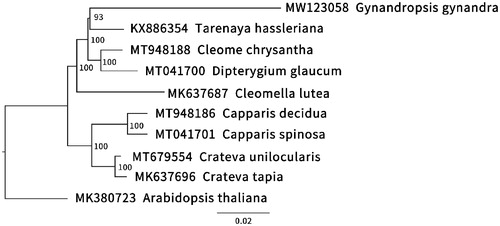Abstract
Gynandropsis gynandra (L.) Briquet is a monoecious herb species in the family Cleomaceae. It is an important commercial crop with medicinal and nutritional values. Here, we sequenced, assembled, and analyzed the complete chloroplast genome of G. gynandra. The circular genome is 158,152 bp in size, consisting of two copies of inverted repeat (IR) regions of 26,181 bp, one large single-copy (LSC) region of 87,242 bp, and one small single-copy (SSC) region of 18,548 bp. The overall GC content was 35.81%. A total of 131 genes were annotated, including 37 tRNA genes, 87 protein-coding genes, and seven rRNA genes. Phylogenetic analysis based on 10 chloroplast genome sequences indicated that G. gynandra was more closely related to Tarenaya hassleriana.
Gynandropsis gynandra (L.) Briquet is a monoecious herb species in the family Cleomaceae. It is widely distributed in many subtropical and tropical regions of the world such as China, India and sub-Saharan Africa (Blalogoe et al. Citation2020). As an important commercial crop, its leaves can provide us with vitamin A, vitamin C, flavonoids and essential minerals (calcium and iron) for medicinal uses. G. gynandra can also be used as a vegetable which is a significant part of leafy vegetable diet for nutritional uses in some African and Asian countries like South Africa and Thailand (Mishra et al. Citation2011). The genus Gynandropsis can offer the potential to understand how C4 photosynthetic pathway evolved from C3 plants, because it contains phylogenetic progression from C3 to C4 photosynthesis (Brown et al. Citation2005). Recently, the complete chloroplast genome of four species from Cleomaceae have been reported, including Dipterygium glaucum, Cleome chrysantha, Cleomella lutea, Tarenaya hassleriana (Guo et al. Citation2017, Alzahrani et al. Citation2020). However, plastid genome sequences of Gynandropsis species remain unknown. In this study, we sequenced and analyzed the complete chloroplast genome of G. gynandra to address this and to identify new regions of genomic variability.
Healthy and fresh leaves of G. gynandra were sampled from adult plants growing at the Guli Town, Jiangning City, Nanjing, Jiangsu Province, China (31.88°N, 118.71°E). The voucher specimen (accession number DS20200516011) was stored at the Herbarium of Nanjing Forestry University (HNFU). Total DNA extraction and whole genome sequencing on the BGI MGIseq2000 platform were conducted by Beijing Biomarker Biotechnology Co. Ltd (Beijing, China). A total of 35,656,412 clean reads were produced and then used for the de novo assembly with NOVOplasty 4.2 (Dierckxsens et al. Citation2016). Gene annotation was performed using the Plastid Genome Annotator (Qu et al. Citation2019).
The complete chloroplast genome of G. gynandra (GenBank accession number MW123058) is a circular molecule of 158,152 bp in length, consisting of two copies of IR (26,181 bp) separated by the LSC (87,242 bp) and SSC (18,548 bp) regions. The overall GC content of the plastome was 35.81%, while the corresponding values of the LSC, SSC and IR regions were 33.42%, 28.55%, and 42.36%, respectively. The chloroplast genome encoded a total of 131 genes, including 87 protein-coding genes, 37 tRNA genes and seven rRNA genes. Among those, 16 protein-coding genes, 14 tRNA genes, and seven rRNA genes were duplicated in the IR regions. 23 genes (11 protein-coding genes, 9 tRNA genes and 3 rRNA genes) contained one intron, two genes (clpP, ycf3) contained two introns, four genes (rpl2, trnA-UGC, ndhB and trnI-GAU) contained three introns, and one gene (rps12) contained four introns.
To identify the phylogenetic position of G. gynandra, we used maximum-likelihood (ML) method by downloading the chloroplast complete gene sequences of four Cleomaceae species, four Capparaceae species and Arabidopsis thaliana of Brassicaceae from the NCBI to make phylogenetic tree (). The 10 chloroplast genome sequence were aligned with MAFFT 7.471 (Nakamura et al. Citation2018), and then the ML tree was constructed by IQ-tree 1.6.12 (Nguyen et al. Citation2015). Our results indicated that G. gynandra was more closely related to T. hassleriana with 93% bootstrap support.
Figure 1. The maximum-likelihood (ML) phylogenetic tree reconstructed by IQ-tree 1.6.12 (Nguyen et al. Citation2015) based on the complete chloroplast genome sequences of G. gynandra and other related species (four Cleomaceae species, four Capparaceae species and Arabidopsis thaliana of Brassicaceae). The bootstrap support value is labeled for each node.

Disclosure statement
No potential conflict of interest was reported by the author(s).
Data availability statement
The genome sequence data that support the findings of this study are openly available in GenBank of NCBI at (https://www.ncbi.nlm.nih.gov/nuccore/MW123058) under the accession no.MW123058. The associated BioProject, SRA, and Bio-Sample numbers are PRJNA687638 (https://www.ncbi.nlm.nih.gov/bioproject/?term=prjna687638), SRR13300171 (https://www.ncbi.nlm.nih.gov/sra/?term=SRR13300171), and SAMN17151087 (https://www.ncbi.nlm.nih.gov/biosample/?term=SAMN17151087), respectively.
Additional information
Funding
References
- Alzahrani D, Albokhari E, Yaradua S, Abba A. 2020. Complete plastome genome of Dipterygium glaucum, Dipterygieae, Cleomaceae. Mitochondrial DNA B. 5(2):1872–1873.
- Blalogoe JS, Odindo AO, Sogbohossou EOD, Sibiya J, Achigan-Dako EG. 2020. Origin-dependence of variation in seed morphology, mineral composition and germination percentage in Gynandropsis gynandra (L.) Briq. accessions from Africa and Asia. BMC Plant Biol. 20(1):168.
- Brown NJ, Parsley K, Hibberd JM. 2005. The future of C4 reasearch – maize, Flaveria or Cleome? Trends Plant Sci. 10(5):215–221.
- Dierckxsens N, Mardulyn P, Smits G. 2016. NOVOPlasty: de novo assembly of organelle genomes from whole genome data. Nucleic Acids Res. 45:18.
- Guo X, Liu J, Hao G, Zhang L, Mao K, Wang X, Zhang D, Ma T, Hu Q, Ai-Shehbaz IA, et al. 2017. Plastome phylogeny and early diversification of Brassicaceae. BMC Genomics. 18(1):176.
- Mishra SS, Moharana SK, Dash MR. 2011. Review on Cleome gynandra. Int J Res Pharm Chem. 1(3):681–688.
- Nakamura T, Yamada K, Tomii K, Katoh K. 2018. Parallelization of MAFFT for large-scale multiple sequence alignments. Bioinformatics. 34:2490–2492.
- Nguyen LT, Schmidt HA, von Haeseler A, Minh BQ. 2015. IQ-TREE: a fast and effective stochastic algorithm for estimating maximum likelihood phylogenies. Mol Biol Evol. 32:268–274.
- Qu XJ, Moore MJ, Li DZ, Ti TS. 2019. PGA: a software package for rapid, accurate, and flexible batch annotation of plastomes. Plant Methods. 15(1):50.
